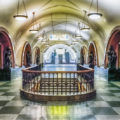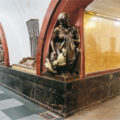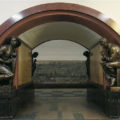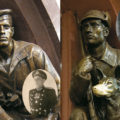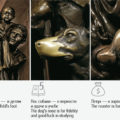The History of the Revolution Square metro station
One of the most impressive and beautiful metro stations in Moscow opened on March 13th, 1938 . The station was named after the square on which it is located. According to numerous theories, the name of the square commemorates the February Revolution of 1917.
How the Revolution Square station was constructed
In 1934 the architect and urban planner Alexey Dushkin, whose name was associated with the construction of the metro and whose works were considered one of the best in the country, won the competition for the project of the future metro station. The original plan of the station design did not include any statues, instead of them it was planned to use bas-reliefs on a revolutionary theme. Dushkin, however, did not like any of the presented ideas. It was decided to seek the advice of the sculptor Matvey Manizer, who suggested decorating the station with a series of bronze statues, dedicated to the themes of revolution, Civil War, and pre-war peace. The architect Alexey Dushkin did not support this idea. In his opinion, the proposed design was more typical for the hall of the Pushkin Museum than for the metro station. Dushkin wrote: “The means of artistic expression must meet the requirements of architectural logic. In this regard, the sculptures, installed at the Revolution Square station, are difficult to justify compositionally.” The authorities, however, liked the project of Matvey Manizer, and the sculptor immediately began his work.
Manizer and his team developed a series of sketches for the sculptures of which 24 themes were approved, out of these 24, 20 ended up being used for the design of the station. There are 40 arches in the station, and in each arch two bronze statues were planned to be installed. There are 76 sculptures in total: 18 scenes are repeated in four identical statues, two of them appear only twice. The sculptures depict in chronological order the events from the October Revolution of 1917 to the composition’s construction in December 1937.
To place the statues in the arches, Manizer had to make them seated, bent, or kneeling. These positions caused outrage among officials and sarcastic jokes among ordinary citizens, who said that the composition accurately depicts the Soviet people, who either “sit” or kneel. However, the work of Manizer was approved by Joseph Stalin himself, and no questions arose after.
Starting from the western escalator of the station, two arches, dedicated to the October Revolution and the Civil War, have sculptures of a Red Guard with a grenade and a soldier with a rifle. The following three niches show the country’s defense after the Civil War. Here we can see the bronze statues of a peasant, a sailor with a revolver, a paratrooper, a signalman from the Marat battleship, a girl with a rifle, and a border guard with a dog. The theme of the next arches is labor and education; it presents a subway builder, an inventor, a hen woman with a chicken and a rooster, a machine operator, a student, and a girl with a book. Three more arches are about family and recreation, showing a disco ball girl, a football player, a mother with a child, and a father with a child. In the last niche, there are figures of pioneers — aircraft designers and geographers.
At the end of 1938 Stalin inspected the new metro stations and highly appreciated the work of Matvey Manizer. Here is what the metro builder and engineer V. Zhukov recalled: “… I look at Comrade Stalin, and it seems to me that he liked our station … Joseph Vissarionovich takes a few steps back, peers deeply at the statues of the fighters for the Soviet power and says: “Great! So lifelike … “.
With the beginning of World War II, the sculptures were evacuated to Central Asia, and they were returned to the capital only in 1944. During the transportation, the bronze statues were badly damaged, later they were restored thanks to the copies that existed of each statue.
The models for the bronze sculptures
Each sculpture was, probably, modeled after an existing person, but today we know the names of only six of these people. The rest will most likely remain a mystery forever.
Two students of the 91st school on Novy Arbat in Moscow Anya Leshchinskaya and Nina Pavlova became the models for the pioneers with the globe. What is interesting is that Matvey Manizer never met these girls and instead used their photographs from the Pionerskaya Pravda newspaper to create the sculptures. Anya and Nina did not know that they were the models for the statues until they saw their bronze images in the metro after the end of the war.
The teacher of the Institute of Physical Education Arkady Gidrat, the champion of the USSR in the high jump, whose achievements were recognized in the media, was invited to be a model for a statue. In June 1941 Gidrat went to the war, and in the fall that same year he was declared missing. Before the remains of his body were found in 2001, his relatives used to bring flowers to the bronze statue of the athlete at the station.
Manizer invited Tamara Kurbatova, a model from his workshop, to be a model for a statue of a disco ball girl.
The cadet of the Naval School Alexey Nikitenko, who was sent to pose for Manizer by the Academy of Arts, became the model for the sailor with a revolver. Subsequently, Nikitenko made a brilliant career in the navy, reaching the rank of first captain.
A graduate of the Naval School Olimpiy Rudakov, whose incredible life is worthy of a book, became the model for the sailor from the Marat battleship. After graduating from college, he was sent to the heroic ship Marat; with the crew of the ship, Rudakov participated in the parade of ships at the British coast in honor of the coronation of King George VI. After returning home, he was selected by Manizer for a statue of a sailor signalman. Having gone through many hardships, Rudakov ended his military career with the rank of vice admiral.
The issue of the model for what is perhaps the most famous sculpture the border guard with a dog raises many questions. It is believed that Hero of the Soviet Union Nikita Karatsupa and his faithful dog Indus were the models for the composition. It is unclear how accurate this theory is. But what is known for sure is that Alexey Dushkin’s German shepherd Irma became the model for the dog. The grandson of the architect Dushkin spoke about this in an interview.
Legends and fables
Perhaps, there is no other station in the Moscow metro full of so many legends and fables as the Revolution Square station. For many years people have gossiped about the various magical qualities of the sculptures of Matvey Manizer.
If early in the morning you touch the flag of the sailor from the Marat battleship, the day will be successful. The same is believed about the revolver of the second sailor, which is why this gun is constantly being stolen.
Anyone, going on a date, is advised to touch the shoe of the bronze girl with the book. No one knows which shoe, right or left, brings good luck, that is why each of them is rubbed to a shine.
The magical qualities of the rooster from “The hen woman” composition are controversial. On the one hand, it is believed that if you rub his comb, you can expect a raise in salary. On the other hand, people believe that the rooster brings misfortune and should not be touched at all. Metro passengers do not ignore the hen woman and often throw notes with wishes into the hem of her bronze robe.
Another talisman of the Revolution Square station is the foot of a child sitting in a man’s lap. The foot is touched by those, whose thoughts and wishes are related to children. People, looking for inspiration and dreaming of success in scientific endeavors, touch the bronze figure of the inventor.
But the main sight of the station is “The border guard with a dog” sculpture. People say that if you rub the dog’s nose, you will pass your exams and tests. There is also an alternative belief. Lovers are advised to rub the dog’s nose because a dog is a true friend of people, which means that if you touch its nose, there will be no betrayal on the part of a loved one. It is not uncommon for people to get off the train to touch the nose of the bronze dog for a couple of seconds, and then jump back into the same carriage. As a result, the bronze coating of the sculpture’s muzzle was practically worn off, and a shepherd dog started to look like a Doberman. This practice forced the local ethnographer Alexander Mozhaev to write an appeal to the management of the Moscow Metro and the Department of Cultural Heritage to take the sculptural composition under protection or at least to place a warning sign next to it. Mozhaev was told that soon the surface of the bronze statues would be coated with a special compound to prevent them from eroding.
Kira Lenskaya

